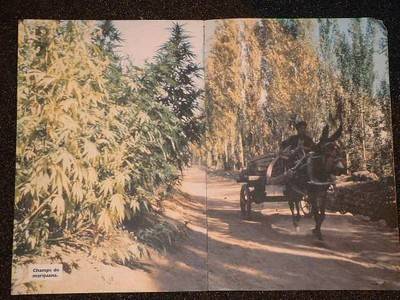well i respect your honesty mate and do appreciate you taking the time to give me some feed back, so thank you sir  i hope you don't mind me responding to your points, though i do see and respect where you're coming from.
i hope you don't mind me responding to your points, though i do see and respect where you're coming from.
i'd say a lot of people other than just myself would disagree with your on that point. you may be right in that there are more contaminated lines today than 30-40 yrs ago, and i'm sure we have lost a few completely, but i fear that "most" is a bit of an exaggeration. i'm not claiming to be leading the revolution here haha i know i'm not, but at the end of the day any efforts whether apparently feeble or not aren't going to hurt the cause, and only work to benefit the community. i have no access to a time machine, and thus can only work to preserve/conserve what's available to us today. unfortunately that's all we can do, though it doesn't mean we shouldn't bother.
as i said in the article, it's not a perfect metaphor, but i think you've misunderstood what i was really trying to say. the pure colours, the initials simple colours back in the 1600-1700s that these renaissance painters would buy powders for and grind up and mix with water to produce <10 or so initial colours like yellow, black, blue, red, white, were the building blocks of all their other colours they produced and used in there painting afterwards. by taking your pure landrace the breeder is taking his building blocks and then mixing, blending them (their very different genetics - like the difference between blue and yellow paints) together to eventually work them into his own unique creation. it was my attempt at using a more simple analogy to try and explain the importance of landrace genetics to the layman, i know it's not a perfect but felt fitting and made for better and more simpler reading/understanding.
you're definitely right, but it is important to at least have the lines as pure as possible and available to others for use in the future than to not have the option at all.
when i stated that it was in the context of returning a strain to the same level of diversity it had prior to the founder effect. yes, it would take 100s of generations and 1000s of years for a population that was numbered in the 10 000s+ with huge variability/heterozygosity, to recover back to the same level of genetic diversity following a founder effect/inbreeding depression where the population was reduced to only a few individuals.
only a handful of generations after a founder effect or inbreeding depression could increase genetic diversity, but yes i'm sure it would take a lot more than a handful of generations over a couple of years to get the strain back to what it once was with respect to genetic diversity.
i'm not afraid to admit or am ashamed of being a "green" on this scene, but one has to start somewhere, sometime, somehow mate. i just feel passionately about the subject and wanted to write about it and share with others.
anyway, once again much respect to you as well mate for giving me your feedback, i honestly appreciate it and hope to get more in the future.

darwin
 i hope you don't mind me responding to your points, though i do see and respect where you're coming from.
i hope you don't mind me responding to your points, though i do see and respect where you're coming from.First of all: Most of the landrace populations are DEAD and or CONTAMINATED. This battle happened and was lost way before your time.
i'd say a lot of people other than just myself would disagree with your on that point. you may be right in that there are more contaminated lines today than 30-40 yrs ago, and i'm sure we have lost a few completely, but i fear that "most" is a bit of an exaggeration. i'm not claiming to be leading the revolution here haha i know i'm not, but at the end of the day any efforts whether apparently feeble or not aren't going to hurt the cause, and only work to benefit the community. i have no access to a time machine, and thus can only work to preserve/conserve what's available to us today. unfortunately that's all we can do, though it doesn't mean we shouldn't bother.
Secondly: Landraces aren't really 'colors.' You're conceiving purple as purple and Durban as Durban. The truth is a landrace is a rather diverse population of heterozygous individuals who are accustomed to a particular environment or selection criteria.
as i said in the article, it's not a perfect metaphor, but i think you've misunderstood what i was really trying to say. the pure colours, the initials simple colours back in the 1600-1700s that these renaissance painters would buy powders for and grind up and mix with water to produce <10 or so initial colours like yellow, black, blue, red, white, were the building blocks of all their other colours they produced and used in there painting afterwards. by taking your pure landrace the breeder is taking his building blocks and then mixing, blending them (their very different genetics - like the difference between blue and yellow paints) together to eventually work them into his own unique creation. it was my attempt at using a more simple analogy to try and explain the importance of landrace genetics to the layman, i know it's not a perfect but felt fitting and made for better and more simpler reading/understanding.
Third: Keeping lines pure isn't the end all be all of any breeding methodology.
you're definitely right, but it is important to at least have the lines as pure as possible and available to others for use in the future than to not have the option at all.
Fourth: It takes 100s of generations and yet 1000s of years to create genetic diversity after a founder effect? Are you sure?
when i stated that it was in the context of returning a strain to the same level of diversity it had prior to the founder effect. yes, it would take 100s of generations and 1000s of years for a population that was numbered in the 10 000s+ with huge variability/heterozygosity, to recover back to the same level of genetic diversity following a founder effect/inbreeding depression where the population was reduced to only a few individuals.
only a handful of generations after a founder effect or inbreeding depression could increase genetic diversity, but yes i'm sure it would take a lot more than a handful of generations over a couple of years to get the strain back to what it once was with respect to genetic diversity.
aren't you a little green to be painting anyone's future?
i'm not afraid to admit or am ashamed of being a "green" on this scene, but one has to start somewhere, sometime, somehow mate. i just feel passionately about the subject and wanted to write about it and share with others.
anyway, once again much respect to you as well mate for giving me your feedback, i honestly appreciate it and hope to get more in the future.


darwin











